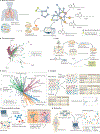Mass spectrometry-based metabolomics in microbiome investigations
- PMID: 34552265
- PMCID: PMC9578303
- DOI: 10.1038/s41579-021-00621-9
Mass spectrometry-based metabolomics in microbiome investigations
Abstract
Microbiotas are a malleable part of ecosystems, including the human ecosystem. Microorganisms affect not only the chemistry of their specific niche, such as the human gut, but also the chemistry of distant environments, such as other parts of the body. Mass spectrometry-based metabolomics is one of the key technologies to detect and identify the small molecules produced by the human microbiota, and to understand the functional role of these microbial metabolites. This Review provides a foundational introduction to common forms of untargeted mass spectrometry and the types of data that can be obtained in the context of microbiome analysis. Data analysis remains an obstacle; therefore, the emphasis is placed on data analysis approaches and integrative analysis, including the integration of microbiome sequencing data.
© 2021. Springer Nature Limited.
Conflict of interest statement
Competing interests
The authors declare no competing interests.
Figures



References
-
- Sender R, Fuchs S & Milo R Are We Really Vastly Out numbered? Revisiting the Ratio of Bacterial to Host Cells in Humans. Cell 164, 337–340 (2016). - PubMed
-
- Claesen J et al. Cutibacterium acnes antibiotic production shapes niche competition in the human skin microbiome.
Publication types
MeSH terms
Grants and funding
LinkOut - more resources
Full Text Sources
Other Literature Sources

